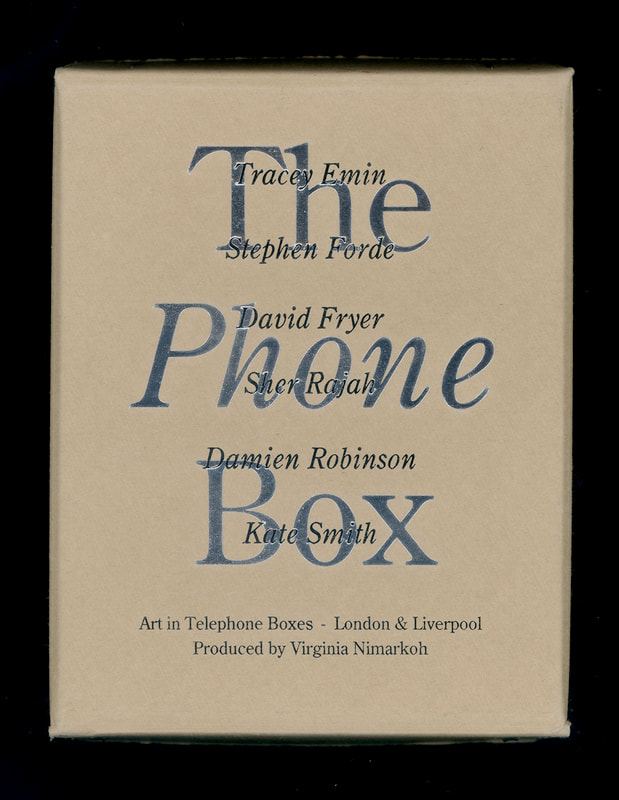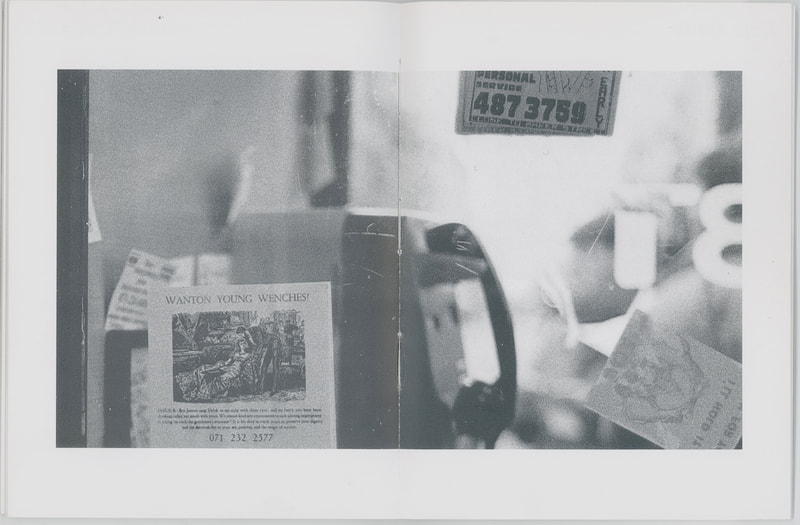The Phone Box (1992/3)
This project was devised and produced by artist Virginia Nimarkoh.
"The Phone Box project took place for three weeks during November of 1992. Public telephone boxes, located within red light areas of London and Liverpool, were used as sites for artworks by Tracey Emin. Stephen Forde, David Fryer, Sher Rajah, Damien Robinson and Kate Smith. The aim of The Phone Box project has been to examine the term 'territory'. Not only in its purely geographical sense but also in relation to personal territory. Essentially, the distinction between public and private space relating to our sense of self, our fantasies and external social boundaries. The telephone box provides the individual with a point of contact, which reaffirms a sense of security. Engrossed in conversation, we become immersed in the illusion of total privacy. Glass walls, intended to keep the world outside, nevertheless highlight our presence. Inhabiting both public and private space simultaneously, the telephone box provides fertile ground for artists to examine the relationship between privacy, personal and public space, and invisibility."
Introduction from project publication.
"The Phone Box project took place for three weeks during November of 1992. Public telephone boxes, located within red light areas of London and Liverpool, were used as sites for artworks by Tracey Emin. Stephen Forde, David Fryer, Sher Rajah, Damien Robinson and Kate Smith. The aim of The Phone Box project has been to examine the term 'territory'. Not only in its purely geographical sense but also in relation to personal territory. Essentially, the distinction between public and private space relating to our sense of self, our fantasies and external social boundaries. The telephone box provides the individual with a point of contact, which reaffirms a sense of security. Engrossed in conversation, we become immersed in the illusion of total privacy. Glass walls, intended to keep the world outside, nevertheless highlight our presence. Inhabiting both public and private space simultaneously, the telephone box provides fertile ground for artists to examine the relationship between privacy, personal and public space, and invisibility."
Introduction from project publication.
"Violet must wait. Is she not aware of the motto 'Il faut me chercher' (I must be sought after)? ... "
From the London Journal, "Advice to Correspondents Column," 1862.
From the London Journal, "Advice to Correspondents Column," 1862.
The phonebox/phoneline phenomena of the red light area offers a seemingly public, but in reality, private area to arrange assignations. I have attempted to mirror this in the public domain by using a Victorian 'problem page' styled card and advice line. At both ends the correspondents are invisible; the cards too are anonymous, no indication being provided as to their origination or purpose.
Phonelines advertised on the cards reinforce their double entendre headlines. Although all the advice is on issues of social etiquette, as with sex lines, it is possible to hear what you want to hear. The customer provides the interpretation that he or she desires.
Calling the number on the card would receive a recording currently mirrored at the location on the link below.
Phonelines advertised on the cards reinforce their double entendre headlines. Although all the advice is on issues of social etiquette, as with sex lines, it is possible to hear what you want to hear. The customer provides the interpretation that he or she desires.
Calling the number on the card would receive a recording currently mirrored at the location on the link below.
|
Review from The Independent, 1992
|
| ||||||
The Phone Box publication
An edition of 600 publications were created with 300 presented as boxed presentations with examples of the artists' project artworks. Published by Virginia Nimarkoh in association with Bookworks.
Coda - 2020
In December 2020, I was tagged into a Twitter conversation, where I had been successfully identified as the artist who created a set of cards from this project. They had turned up in a batch of four thousand cards being digitised by Jason Scott, a historian and archivist working for The Internet Archive. While I had worked on the principle that the cards would be destroyed or disposed of during the project, at least one has survived "in the wild" for thirty years. As I had my own archived copies and proof sheets, I sent scans of the full set to Jason who kindly added them to the Internet Archive. If you come across one of the cards - or any other works from the project - please do let me know.
2024: and another card surfaces
In April 2024, I was contacted by Will Meister, who kindly got in touch to furnish another surviving card's life story:
|
"...I can extend the active life of the "Phone Box" project beyond your 2020 exchange with Jason Scott.
I lived in London throughout the late 80s and the 90s. I was completely fascinated by the ways of the city and collected all sorts of ephemera, including the more interesting escort cards from phone boxes.... I found one of your "Vicar's Vicissitudes" cards near Kings Cross in 1992 and had a similar response to Jason's -- "Hey, that's really interesting -- it's not a real ad, or is it?" The postcard went into my files and stayed there. Several years later I saw Tracey Emin's "Try Tracey" card from 1992 and the mystery was solved...” |




